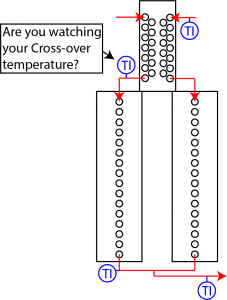We had 50 refiners from 21 different plants represented in the Delayed Coker Process and Troubleshooting Training course at RefComm® Galveston 2017. Lots of different viewpoints were shared from all sizes and designs of equipment. One of the more exciting group exercises conducted was a simple benchmarking around the room regarding heater performance.
Specifically, we dug into heater inlet, crossover, and coil outlet temperatures in conjunction with fouling rates and decoking strategies. The details of the benchmarking are for the course participants to retain and will not be shared online (sorry). However, lots of variation exists but some interesting observations jumped out. Let’s just discuss one, CROSSOVER TEMPERATURE.

After many site visits and years of teaching, it is my opinion that many sites do not pay close enough attention to the crossover (XOT) temperature. Crossover temperature is the temperature coming out of the convection and going into the radiant. Not all heaters have process preheat or this configuration but most do in the delayed coker. It is well known that higher crossover temperatures generally lead to higher fouling in the radiant section because the time above the magic coking temperature (800F, 444C) all things being equal increases with increasing XOT. However, this was only true in the extreme cases, >750F. Most sites were operating between 700-720F XOT. Fouling rates, as defined by rise in tube metal temperature (TMT) per day, varied from 1-10+ degF/day. Therefore, other design (flux, velocity, etc) and fluid composition (MCR, HIS, SARA, Na, etc.) variations are at work.
Where the XOT becomes important is in the observation and diagnosis of changing heater performance from both the flue gas side and process side. Subtle shifts can indicate changes in fouling, cracking tendency (created by compositional differences), and fire side absorption. If the XOT drops low, it may be because of fouling in the tubes decreasing the absorption of flue gas energy or a change in the cracking rate due to a highly paraffinic feed. Teasing these two phenomena apart is the challenge and will need to be covered in another post. Think of XOT as just as powerful a process indicator as coil outlet temperature (COT) on the delayed coker furnace.
During a plant visit, we discovered the XOT thermowells had been removed. They were still shown on the P&ID but no longer in the field. The exact reason for this change was not known to the site, indicating the change occurred many years ago. No one there really seemed to be concerned about this change indicating the lack of understanding behind the utility of this measurement.
Paying increased attention to the XOT is a smart way to optimize heater performance. Take 10 minutes and trend yours over a 5-year period. What do you see? I bet there will be some outlier situations that require more investigation. You never know, you might discover a hidden gem to optimize your unit. Every furnace is different. What secrets is yours hiding…?
One response to “Highlights from RefComm® Galveston 2017: Pay Attention to Furnace Crossover Temperature (XOT)”
Leave a Reply
You must be logged in to post a comment.







Evan, I agree that the cross over temperatures need to be monitored and that there are a number of variables that determine the allowable value. Residence time over 800 F or 425 C (not the 444 C you listed above) is one of the criteria. It is normally not controlling for fouling of the convection section, but can contribute to the fouling in the radiant section as the amount of time above the cracking temperature increases.